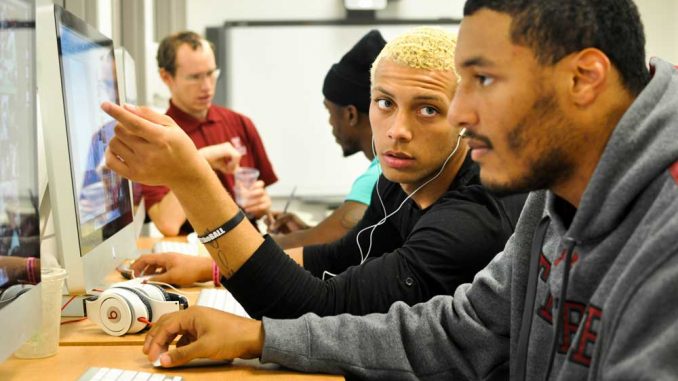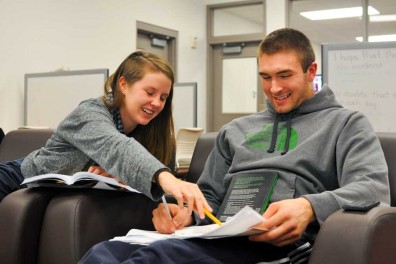
Come mid-October, Shawn Fagan is a busy guy.
Amid the few days leading up to the priority registration date, the principle advisor for Temple’s cross country, baseball and softball teams sat in his Pearson Hall cubicle at the Student-Athlete Academic Advising & Support Center and continued to work with his student-athletes one by one on each of their prospective class schedules well after business hours had ceased.
Fagan said he worked until 11 p.m. on Monday and Tuesday and 10 p.m. on Wednesday of last week leading up to the beginning of priority registration Thursday, Oct. 24.
Last week marked the onset of registration time, a period in which Fagan’s office enters overtime mode in helping Temple’s student athletes sure up each of their spring schedules, surely with the aid of an extra cup of coffee or two.
Despite the flashy picture painted on many cable television networks, the life of a college athlete is one of structure, commitment and little free time. Student-athletes have to deal with a full class load, take exams, write papers and labor on assignments and weekly doses of reading just like any one of Temple’s more than 27,000 undergraduate students.
Then add an NCAA Division I sport to the mix.
“I think a lot of people take for granted what student-athletes do,” cross country sophomore Will Maltin said. “Some people think they just go out there and perform and get praise for doing it, but there’s a lot of hard work that goes into it not just on the field, but off it as well in the classroom. A lot of the kids on my team have pretty challenging majors and I know other teams have that as well. Doing a sport in college is a huge commitment… it’s no easy task.”
The NCAA has modernized the academic phase of college athletics in recent years, thanks in part to the introduction of the Academic Progress Rate in 2004, which accounts for an institution’s success in retaining and graduating student-athletes, as well as the ability for each athlete to pass NCAA-mandated academic requirements each semester, according to the NCAA’s website.
One point is counted per athlete for staying in school and remaining academically eligible each semester, Fagan said. The percentage of total points racked up for each student against the highest amount of points possible per team is then multiplied by 1,000 to yield a team’s APR. One thousand is the highest possible APR score.
Along with the newly-instituted APR came a standard, as teams that receive below a 925 APR in one year can receive immediate punishment, while teams that score below a 900 can face additional sanctions in historical penalties.

Temple became one of the NCAA’s first experiments in punishing schools for a low APR, as the football team suffered a hit of nine less scholarships after scoring an 837 in 2004-05, and also faced the NCAA’s sanctions with respective scores of 858, 868 and 891 across the team’s next three seasons.
Along with the scholarship hit, the team also faced two cases of public warning as well as a reduction in practice time in 2006-07. The team has seen a steady increase in APR as well as its graduation success rate statistic in years since, and scored an APR of 963 in 2011-12, the program’s highest to date and the highest number in the Big East Conference last year, said SAAASC director Justin Miller.
Baseball (2005-06, 2006-07), men’s soccer (2006-07) and men’s indoor track (2006-07) have also faced NCAA sanctions in the past, and have since improved vastly. Men’s soccer hit an APR mark of 976 in 2011-12, while the men’s indoor and outdoor track teams scored 992 in 2011-12, high scores for all three programs.
Despite some struggles in the mid-2000s and even before that period, Temple has since improved greatly by the numbers.
Per Miller, all NCAA D-1 athletes had a cumulative GPA of 3.08 in the spring of 2013, Temple’s third consecutive year of a cumulative GPA above 3.0 and the highest cumulative number on record. Three hundred and seventeen student-athletes also scored above a 3.0, while 147 students eclipsed the 3.5 mark, both program highs.
While the introduction of APR and the penalties that can roll in with poor academic performance have helped stiffen the attitude toward student-athlete academics in recent years, a rejuvenated staff has helped as well.
Fagan, who joined in 2009, is one of six full-time advisers and 10 full-time staff members in the SAAASC. Advisers help map out student-athletes’ class schedules come registration time, and also keep the coaches up to date with each of their athletes’ academic standing.
“I want to impact their lives positively so that they can leave Temple with a skill and have a great experience here,” Fagan said. “Hopefully I can have an impact along the way and that they were happy to have me as a resource to them. My goal is for all of them to earn their degrees and put something in place to help them graduate, and pushing them to apply themselves as opposed to just pushing through.”
Outside of the advising component, the SAAASC provides tutoring services to student-athletes. There is also a Temple-mandated study hall period for freshmen, as well as multiple study lounges and newly-added Mac computers located in the facility for study and other school-related purposes.
While playing and partaking in a sport is a significant part of the student-athlete title, baseball coach Ryan Wheeler said there is a reason they’re referred to as “student-athletes” as opposed to ordinary athletes.
“I certainly believe in academics,” Wheeler said. “It’s the reason why these guys are in college, to get their education. Most of them aren’t going to get the opportunity to play beyond here, but getting that degree is why they’re here.”
Andrew Parent can be reached at andrew.parent@temple.edu or on Twitter @daParent93.


Be the first to comment